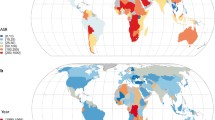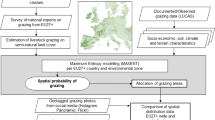Abstract
Livestock remains the world’s largest user of land and is strongly related to grassland and feed-crop production. Assessments of environmental impacts of livestock farming require detailed knowledge of the presence of livestock, farming practices, and environmental conditions. The present Europe-wide livestock distribution information is generally restricted to a spatial resolution of NUTS 2 (province level). This paper presents a modelling approach to determine the spatial distribution of livestock at the landscape level. Location factors for livestock occurrence were explored and applied to consistent and harmonized EU-wide regional statistics to produce a detailed spatial distribution of livestock numbers. Both an expert-based and an empirical approach were applied in order to disaggregate the data to grid level. The resulting livestock maps were validated. Results differ between the two downscaling approaches but also between livestock types and countries. While both the expert-based and empirical approach are equally suited to modelling herbivores, in general, the spatial distribution of monogastrics can be better modelled by applying the empirical approach.


Similar content being viewed by others
Notes
The EU27 comprises the 15 member countries of the European Union before the expansion in 2004 plus the 12 member countries that joined the European Union in 2004.
The spatial allocation of livestock was done based on a simplified CORINE Land Cover 2000 map. For that the 44 CORINE land cover classes were aggregated to 10 land cover classes (Verburg and Overmars 2009).
References
Arendonk JAM v, Liinamo A-E (2003) Dairy cattle production in Europe. Theriogenology 59:563–569. doi:10.1016/S0093-691X(02)01240-2
Aspinall RJ (2004) Modelling land use change with generalized linear models—a multi-model analysis of change between 1860 and 2000 in Galatin Valley, Montana. J Environ Manag 72(1/2):91–103. doi:10.1016/j.jenvman.2004.02.009
Barnard CS, Nix JS (eds) (1979) Farm planning and control. Cambridge University Press, Cambridge
Bolsius ECA (1993) Pigs in space. Spatial reconnaissances. National Spatial Planning Agency, Ministry of Housing, Spatial Planning and the Environment, The Hague
Boogaard HL, Eerens H, Supit I, van Diepen CA Piccard I, Kempeneers P (2002) Description of the MARS crop yield forecasting system (MCYFS). METAMP report, Alterra, Wageningen, The Netherlands and VITO, Mol, Belgium and Supit Consultancy, Houten
Cook CW (1966) Factors affecting utilization of mountain Slopes by cattle. J Range Manag 19(4):200–204. doi:10.2307/3895647
de Haan CH, Steinfeld H, Blackburn H (1997) Livestock and the environment: finding a balance. WRENmedia, Suffolk
Det Jordbrugsvidenskabelige Fakultet (2000) Available online at http://www.djfgeodata.dk. Last accessed 25 Mar 2009
EEA (2005) IMAGE2000 and CLC2000. Products and methods. CORINE land cover updating for the Year 2000. Ispra, Italy
Elbersen B, Kempen M, Diepen K van, Andersen E, Hazeu G, Verhoog D (2006) Protocols for spatial allocation of farm types. SEAMLESS report no. 19, November 2006
Eurofarms (2009) Available online at http://www.eurofarms.com. Last accessed 25 Mar 2009
European Commission (2007) The meat sector in the European Union. European Commission Directorate-General for Agriculture, Brussels
Eurostat (2007) Available online at http://epp.eurostat.ec.europa.eu/cache/ITY_SDDS/EN/ef_base.htm. Last accessed 25 Mar 2009
FAOSTAT (2006) Available online at http://faostat.fao.org/. Last accessed 25 Mar 2009
Farm Accountancy Data Network (FADN) (2003) Available online at http://ec.europa.eu/agriculture/rica/index_en.cfm. Last accessed 25 Mar 2009
Food and Agriculture Organization of the United Nations (FAO) (2007) Gridded livestock of the world 2007. Food and Agriculture Organization of the United Nations (FAO), Rome, p 131
Harris NR, Johnson DE, George MR, McDougald NK (2002) The effect of topography, vegetation, and weather on cattle distribution at the San Joaquin experimental range, California. USDA Forest Service Gen. Tech. Rep. PSW-GTR-184
Hellsten S, Dragosits U, Place CJ, Vieno M, Dore AJ, Misselbrook TH, Tang YS, Sutton MA (2008) Modelling the spatial distribution of ammonia emissions in the UK. Environ Pollut 154(3):370–379. doi:10.1016/j.envpol.2008.02.017
Hooda PS, Edwards AC, Anderson HA, Miller A (2000) A review of water quality concerns in livestock farming areas. Sci Total Environ 250:143–167. doi:10.1016/S0048-9697(00)00373-9
Instituto Nacional de Estatística (2000) Recenseamentos Gerais da Agricultura. Dados Comparativos 1989–1999. Lisboa
Kempen M, Heckelei T, Britz W, Leip A, Koeble R, Marchi G (2006) Computation of a European agricultural land use map—statistical approach and validation. Agricultural and Resource Economics, Discussion Paper 2005:1 1
Kruska RL, Reid RS, Thornton PK, Henninger N, Kristjanson PM (2003) Mapping livestock-oriented agricultural production systems for the developing world. Agric Syst 77:39–63. doi:10.1016/S0308-521X(02)00085-9
Mertens B, Poccard-Chapuis R, Piketty M-G, Lacques A-E, Venturieri A (2002) Crossing spatial analyses and livestock economics to understand deforestation processes in the Brazilian Amazon: the case of São Félix do Xingú in South Pará. Agric Econ 27:269–294
Metzger MJ, Bunce RGH, Jongman RHG, Mücher CA, Watkins JW (2005) A climatic stratification of the environment of Europe. Glob Ecol Biogeogr 14:549–563. doi:10.1111/j.1466-822X.2005.00190.x
Micale F, Genovese G (eds) (2004) Methodology of the MARS crop yield forecasting system. Vol. 1: meteorological data collection, processing and analysis. ISBN 92-894-8130-3—EUR 21291/EN/1
Mueggler WF (1965) Cattle distribution on steep slopes. J Range Manag 18(5):255–257. doi:10.2307/3895492
Naeff HSD (2006) Geactualiseerd GIAB-bestand 2003 voor Nederland. Intern rapport Alterra, Wageningen
Nielsen AH, Kristensen IS (2005) Nitrogen and phosphorus surpluses on Danish dairy and pig farms in relation to farm characteristics. Livest Prod Sci 96:97–107. doi:10.1016/j.livprodsci.2005.05.012
Oenema O, Oudendag DA, Velthof GL (2007) Nutrient losses from manure management in the European Union. Livest Sci 112:261–272. doi:10.1016/j.livsci.2007.09.007
Overmars KP, Verburg PH (2005) Analysis of land use drivers at the watershed and household level: linking two paradigms at the Philippine forest fringe. Int J Geogr Inf Sci 19:125–152. doi:10.1080/13658810410001713380
Pérez-Soba M, Mücher CA, Elbersen BS, Godeschalk FE, Roos J et al (2001) The allocation of dairy systems in the 15 countries of the European Union based on farm statistics and land cover: a case study from The Netherlands. In: Bunce RGH (ed) Examples of European agri-environment schemes and livestock systems and their influence on Spanish cultural landscapes. Alterra Report 309, Wageningen, The Netherlands, pp 193–203 ISSN 1566-7197
Petit S, Elbersen BS (2006) Assessing the risk of impact of farming intensification on calcareous grasslands in Europe. Ambio 35(6):2–5. doi:10.1579/06-R-125R.1
Pontius RG, Huffaker D, Denman K (2004) Useful techniques of validation for spatially explicit land-change models. Ecol Model 179:445–461. doi:10.1016/j.ecolmodel.2004.05.010
Statistisches Bundesamt (2001) Viehbestand Mai 2001 nach kreisfreien Städten und Landkreisen
Steinfeld H, Gerber P, Wassenaar T, Castel V, Rosales M, de Haan C (2006) Livestock’s long shadow: environmental issues and options. FAO, Rome
Van Groenigen JW, Schils RLM, Velthof GL, Kuikman PJ, Oudendag DA, Oenema O (2008) Mitigation strategies for greenhouse gas emissions from animal production systems: synergy between measuring and modeling at different scales. Aust J Exp Agric 48:46–53. doi:10.1071/EA07197
Verburg PH, Overmars KP (2009) Combining top-down and bottom-up dynamics in land use modeling: exploring the future of abandoned farmlands in Europe with the Dyna-CLUE model. Landscape Ecol. doi:10.1007/s10980-009-9355-7
Verburg PH, van Keulen H (1999) Exploring changes in the spatial distribution of livestock in China. Agric Syst 62(1):51–67. doi:10.1016/S0308-521X(99)00055-4
Acknowledgments
The authors acknowledge EURURALIS, NITROEUROPE, and the BSIK RvK IC2 project ‘Integrated analysis of emission reduction over regions, sectors, sources and greenhouse gases’ for the funding of the research leading to the present publication. We especially thank Hans Kros for critical discussions about the developed methodology. Finally we thank Han Naeff for processing the Dutch GIAB data.
Author information
Authors and Affiliations
Corresponding author
Rights and permissions
About this article
Cite this article
Neumann, K., Elbersen, B.S., Verburg, P.H. et al. Modelling the spatial distribution of livestock in Europe. Landscape Ecol 24, 1207–1222 (2009). https://doi.org/10.1007/s10980-009-9357-5
Received:
Accepted:
Published:
Issue Date:
DOI: https://doi.org/10.1007/s10980-009-9357-5




